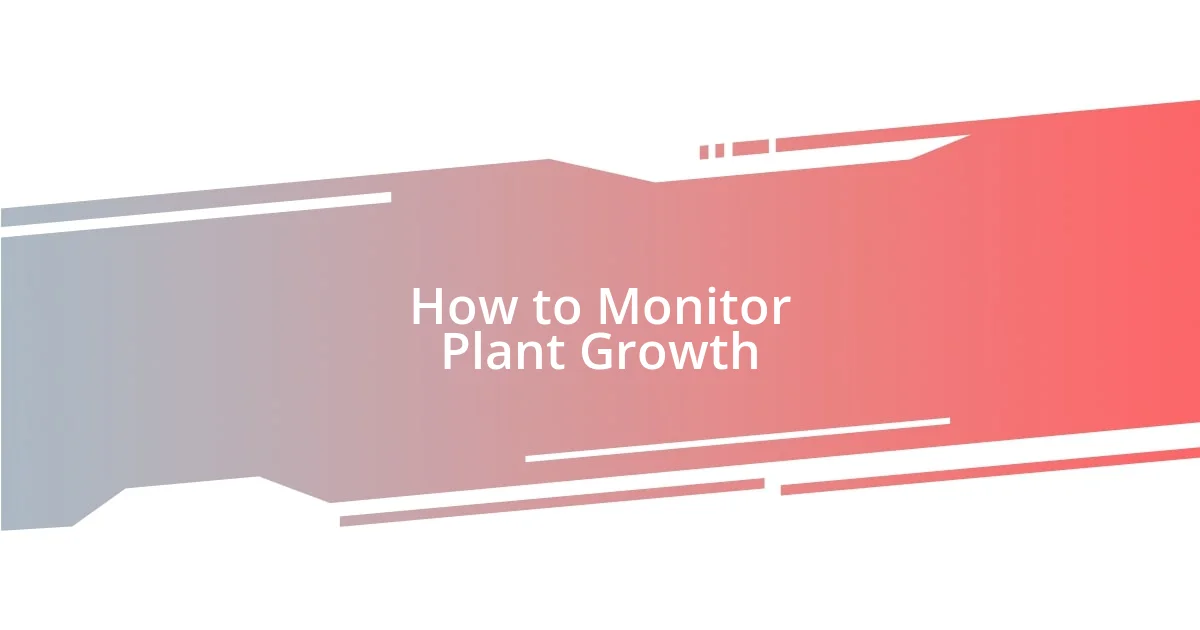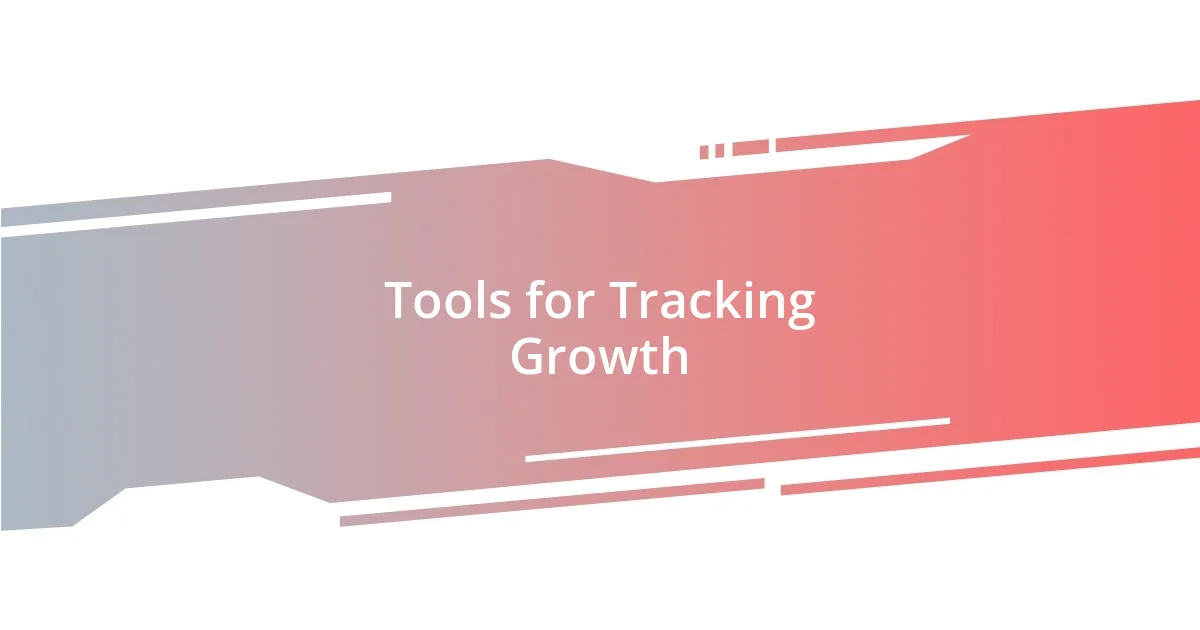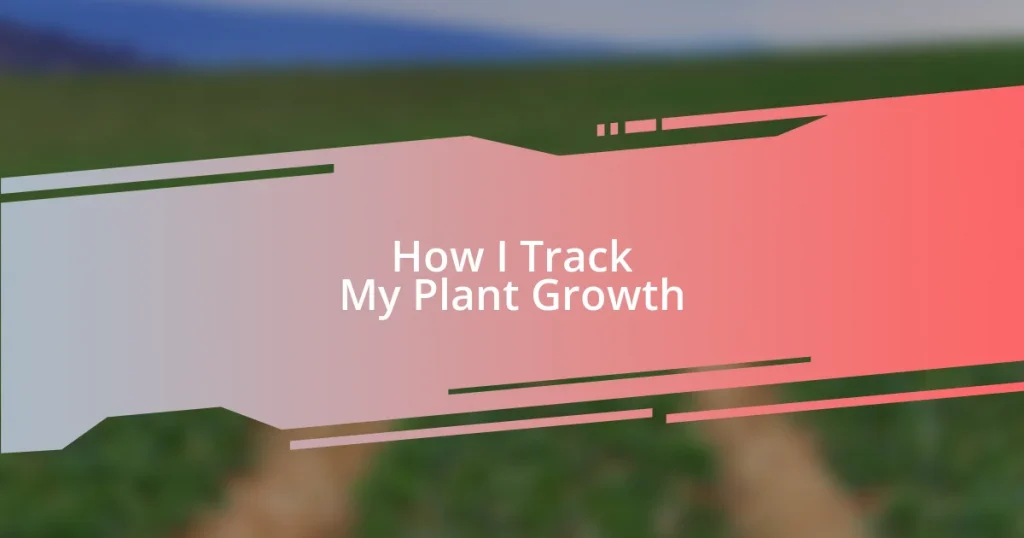Key takeaways:
- Maintaining a growth journal enhances the connection with plants, capturing key observations and milestones over time.
- Utilizing various tracking tools, such as mobile apps and photo archives, helps monitor plant progress and care routines effectively.
- Analyzing growth data reveals trends and insights that influence care strategies and deepen the understanding of the gardening process.

How to Monitor Plant Growth
Monitoring plant growth is a journey filled with both excitement and curiosity. I often take a few minutes each week to observe my plants, noting changes in color, leaf size, and overall vigor. Each little development feels like a personal victory—like my plants are rewarding me for the care I provide them.
I find keeping a growth journal incredibly helpful. In my experience, I jot down key observations, such as when I first notice new leaves or flowers blooming. Reflecting back on these notes not only tells me how well my plants are doing but also reminds me of the small victories that come with nurturing life.
Have you ever considered how changes in your plants might mirror your own life’s growth? When they flourish, it feels like a shared achievement. For me, monitoring growth isn’t just about measuring height; it encapsulates an entire process—patience, care, and a little bit of happiness as I watch nature unfold.

Tools for Tracking Growth
When it comes to tracking growth, I’ve discovered a variety of tools that really enhance my gardening experience. One of my favorites is a simple smartphone app dedicated to plant care. It allows me to set reminders for watering, feeding, and monitoring sunlight exposure, which is particularly useful during busy weeks. I still remember the times I forgot to check on my succulents, which definitely taught me the importance of staying organized!
Here are some valuable tools I use for tracking plant growth:
- Growth Journal: I keep a dedicated notebook to jot down growth milestones, which helps me see patterns over time.
- Mobile Apps: Applications like “Garden Journal” or “PlantSnap” streamline my tracking efforts with visual progress graphs.
- Rulers and Measuring Tape: Simple and effective; I measure height and girth to document physical changes.
- Photo Archive: I regularly snap photos of my plants, helping me visually compare their progress across seasons.
- Calendar Reminders: Setting alerts for specific care tasks keeps me accountable and attentive to my plants’ needs.
By utilizing these tools, I feel more connected to my plants and their growth—like I’m sharing a journey with each one.

Creating a Growth Journal
Creating a growth journal has become one of my most cherished gardening rituals. Each time I sit down to write, I feel a sense of peace wash over me, knowing that I’m capturing a moment in time. I often include the date, weather conditions, and any unique experiences with my plants. For example, I once wrote about a stubborn little fern that took weeks to sprout new leaves; when it finally did, I could hardly contain my excitement!
What I find particularly rewarding is looking back at my entries over the months. It’s fascinating to see how far my plants have come—and how much I’ve learned. I recall the first time I wrote about my orchids struggling to bloom. I documented my trial and error with light adjustments and watering techniques and eventually celebrated when those vibrant flowers finally exploded into color. Each success feels like a shared triumph between me and my plants.
A growth journal can also be a source of inspiration. When I flip through its pages, I’m reminded of each journey and challenge. Perhaps it’s the same for you—do you find that writing things down helps clarify your thoughts? I certainly do. Not only does it provide invaluable insight into improving my gardening practices, but it also serves as a motivational reminder of the beauty that blooms from patience and perseverance.
| Aspect | Description |
|---|---|
| Frequency | Weekly updates to reflect changes and growth |
| Details Captured | Date, weather conditions, observations |
| Emotional Connection | Creates a deeper bond with plants |

Measuring Specific Growth Metrics
Measuring specific growth metrics is an enjoyable aspect of my plant care routine. For instance, I use a ruler to regularly measure the height of my basil plants. Just the other day, I noted a growth of two inches in just a week! Watching them thrive gives me such a sense of accomplishment—it’s like witnessing a small miracle right in my kitchen.
Girth measurement is another intriguing metric I focus on. I still remember the first time I measured the stem of my monstera. It was barely half an inch, and now, it’s grown to an impressive three inches! I often wonder why it feels so rewarding to see physical changes in my plants. Perhaps it’s because each measurement tells a story of resilience and adaptation.
Additionally, documenting leaf count is something I find fascinating. Tracking how many leaves my spider plant produces not only highlights its growth but also how well it’s responded to my care. Just last month, I counted 15 new leaves, which left me grinning from ear to ear. Have you ever experienced that thrill? It’s incredible to see the tangible results of your efforts—almost like a reflection of your nurturing spirit.

Understanding Growth Stages
Understanding the growth stages of plants is essential for effective tracking and nurturing. I remember when I first started gardening; I was utterly fascinated to learn about the germination stage. Seeing those tiny sprouts emerge from the soil felt like watching a miracle unfold. Have you ever planted a seed and waited eagerly for the moment it breaks through? That initial delicate phase is where it all begins, setting the foundation for everything that follows.
As my plants developed, I became more attuned to the next stages—vegetative growth and flowering. In my experience, the vegetative stage can seem endless, yet it’s where I truly bond with my plants. I recall nurturing a tomato plant that seemed stubborn at first, refusing to grow beyond a certain height. Through patience, I realized that proper light and nutrients made all the difference. Observing my tomato flourish into a robust plant was incredibly satisfying—it’s a reminder of how attentive care can lead to transformations.
Finally, witnessing the flowering stage is honestly a reward unlike any other. I still feel that rush of joy from the day my first sunflower bloomed. I had watered and cared for it diligently, and when those golden petals finally opened, the feeling was euphoric. The beauty of blossoms is a testament to the nurturing journey we undertake as gardeners, isn’t it? Each phase, with its unique challenges and rewards, ultimately teaches us about growth—not just in plants but in our own lives, too.

Tips for Consistent Tracking
Tracking plant growth consistently is all about establishing a routine that works for you. Personally, I take a few moments each week to jot down my observations, like how often I water and any changes I notice. Have you tried setting a specific day for tracking? It creates a lovely rhythm in my plant care, almost like a weekly celebration of growth.
I also find that using visuals makes a huge impact. I like to snap a quick photo of my plants each week. This way, I can literally see the changes over time, and it sparks such joy to scroll through my gallery of plant progress. It’s like a visual diary, and sometimes I find myself smiling at how much my little green friends have transformed. Have you ever looked back at your photos and felt that surge of pride?
Lastly, don’t underestimate the power of collaboration and community. I’ve joined a couple of gardening groups online, where we share our tracking methods and growth updates. The support and encouragement make the process so much more meaningful. Engaging with fellow plant lovers reminds me that every measurement and observation counts, and it truly enhances the joy of tracking our botanical journeys together.

Analyzing Growth Data and Trends
Analyzing growth data has become a fascinating part of my gardening experience. I often create simple spreadsheets to visualize my plants’ progress over time. The first time I tracked the height of my basil plant, I was amazed to see it grow three inches in just a week! Doesn’t it feel incredible to see those numbers translate into vibrant green leaves?
One aspect I particularly enjoy is looking for trends in the data. For instance, while observing my pepper plants, I noticed that they thrived better after I adjusted their watering schedule. It made me reflect on how little changes in our care routines can lead to significant outcomes. Have you ever tracked something and discovered a pattern that surprised you? Those “aha” moments can deepen our connection with our plants.
Additionally, I find it valuable to connect my growth analysis with seasonal changes. When I don’t see expected progress, I often tie my observations back to factors like sunlight or temperature fluctuations. Recently, my indoor ferns slowed down in growth during a colder spell, and reflecting on this taught me the importance of adapting my care. These insights not only help the plants thrive but also enrich my knowledge and appreciation of the growing process.















